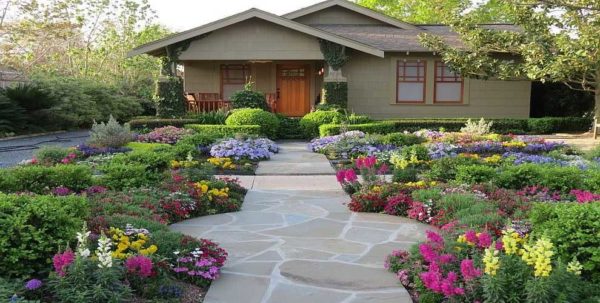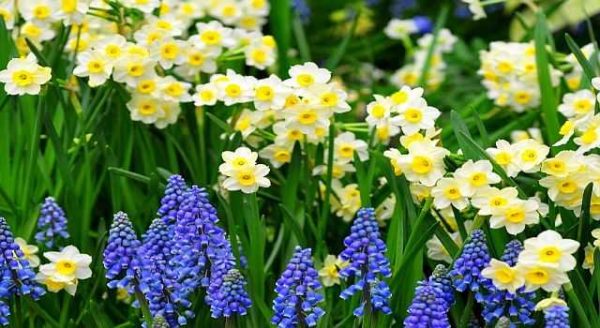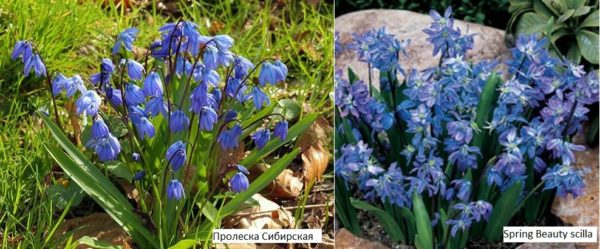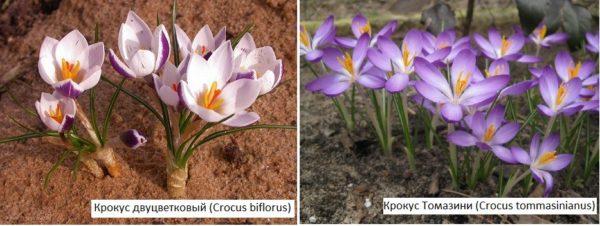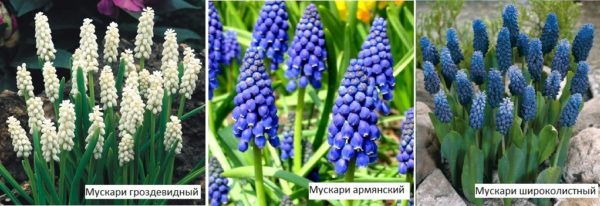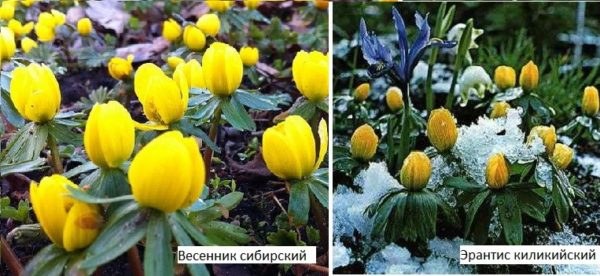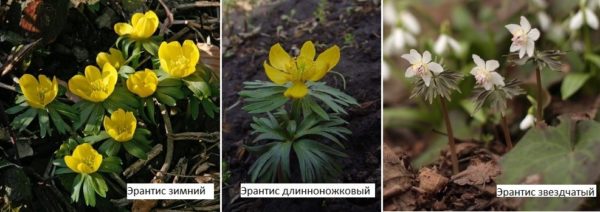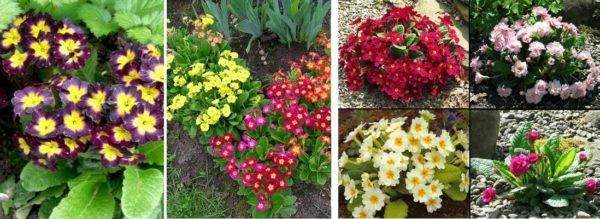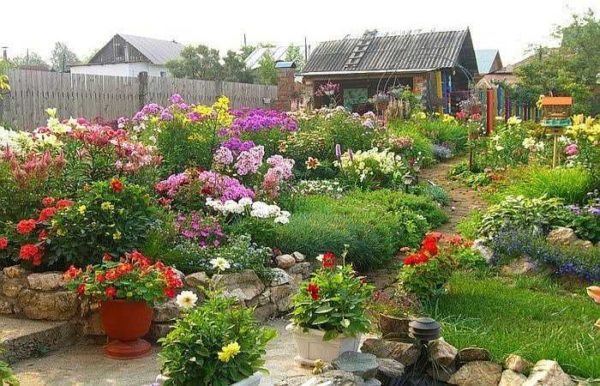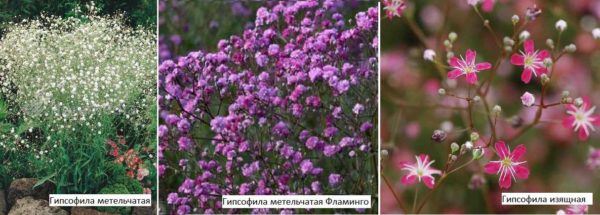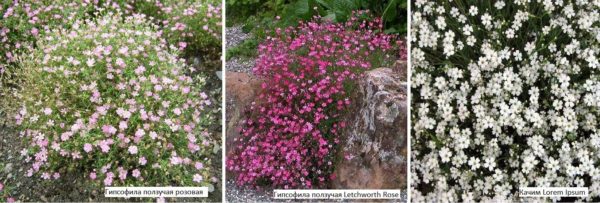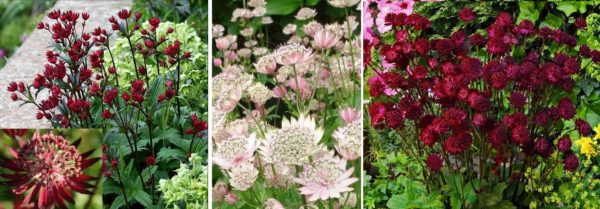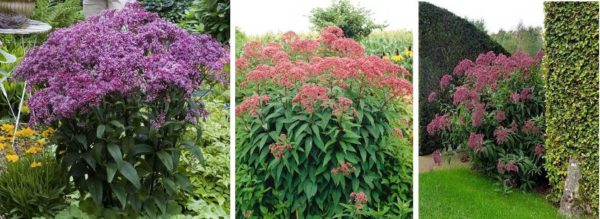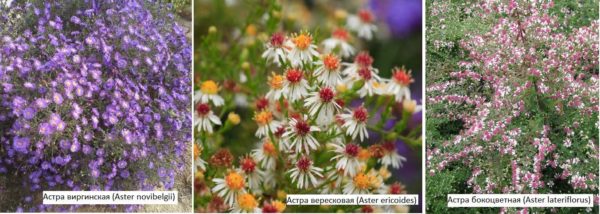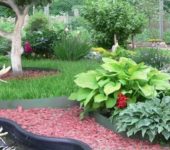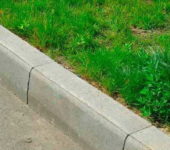What flowers to plant in the country? Perennial garden flowers
Making out flower beds, rock gardens, rabatki, framing lawns, we try to select unpretentious garden flowers in care. Especially if these are flowers for a summer residence. There is usually more than enough work, there is not always enough strength for capricious plants. We will publish a selection of beautiful and varied flowers with different flowering periods - from early spring to late autumn. You just have to choose according to your taste and color.
The content of the article
Spring bloom
There are very early flowers that delight us even before the grass even appears. What is noteworthy, they are very unpretentious, require almost no maintenance. Well-known spring flowers for summer cottages are daffodils and tulips. They are very diverse and beautiful, but there are many others, no less interesting.
Snowdrops
These small bulbous plants with delicate white flowers are known to everyone. The correct name is Galanthus nivalis - Galanthus. They appear immediately after the snow melts, bloom in just a couple of weeks, but the flowering is very short. After the end of the flowering season, the aerial part dies off. It is recommended to plant near shrubs and trees.
There are about two dozen varieties in total, here are the most interesting and popular:
- Viridapis. Taller variety. Blooms in February-March. The leaves are grayish green, flat. Their length is about 10 cm. The flower is white, drooping, 1-3 cm long. There are green spots on the edges of the inner petals.
- Lutescens. It differs in that the inner petals have yellow spots. This variety of snowdrops is capricious - not all soils suit it.
- Pusi Green Tip, Ophelia, Flore Pleno - varieties with terry snow-white flowers.
- Snow white or snowy. Low-growing variety - 10-15 cm high with miniature flowers.
- Elvis. Tall - height 15-25 cm, oblong and wider leaves have a bluish tint. The flower is more spherical. Of all the varieties, the earlier one blooms in February in the southern regions.
There are also blue snowdrops. This is another kind of flowers - Scilla (scilla), but they are more often called Proleski. They are more fragile in appearance, bloom a little later - in April. They tolerate winter well, are unpretentious, can grow on heavy fertilized soils. For them to bloom in spring, you need to feed them with nitrophos. Common varieties:
- Siberian beetle. Leaves are basal, wide, bright green. It produces tall peduncles 10-12 cm high, on which there are from 1 to 5 blue-blue drooping flowers. Early flowering - 10-15 days after the snow melts. There is a white subspecies with a later flowering.
- Spring Beauty. It produces powerful purple-green arrows, on which are placed - 5-6 large flowers with a diameter of about 3 cm. The color of the flowers is dark purple. Reproduces by children.
There are even rarer varieties, but they are difficult to find, and they are more capricious when grown. The combination of white and blue snowdrops looks very attractive.
Crocuses
Another bulbous flowers. They bloom in the same period as snowdrops, have similar sizes, but the color is more diverse - there are white, yellow, purple, purple. For greater effect, it is better to plant in groups, mixing colors. You can plant it anywhere - under trees and shrubs, in an open place. They belong to the sun-loving, but they also tolerate the shade, they normally winter under the snow. It can be planted - in the ground, you can - in containers.
There are quite a few varieties that differ in flowering time, plant height and color intensity:
- Two-flowered crocus (Crocus biflorus). It has a very interesting color. There are white, white with purple stripes on the outside of the petals, white on the inside, with lilac-blue spots on the outside of the petals, with purple-brown stripes. The mouth of this crocus species is white or yellow.
- Spring crocus (Crocus vernus). Large plant up to 17 cm high. The tuber is flattened, covered with scales. Leaves are narrow, long with a silvery-white stripe in the middle. The flowers are white or purple, the shape is bell-shaped, elongated. One or two flowers can grow from one tuber. The flowering time is late April, early May, the flowering period is about 3 weeks.
- Golden crocus (Crocus chrysanthus). Tall variety - up to 20 cm in height. The leaves are narrow and long, the flowers are golden-yellow in color, with brown stripes or tan marks on the outer part of the petals. Columns are red, anthers are orange. Bloom in April for 3 weeks.
- Crocus tommasinianus. Low-growing variety - up to 6 cm tall. One bulb can produce up to 3 flowers. Coloring - pinkish-lilac, a white border can pass along the edge. The open flower looks like a star with a white center and a white anther. Blooms in April, flowering period - up to 3 weeks.
Crocuses on a flower bed or lawn look very bright and delicate. They are excellent for planting on stones, in free-standing small flower beds, discounts. After the end of the flowering period, the aerial part dies off. These primroses are excellent flowers for a summer residence that will delight you when there is still no grass.
Muscari
Moisture-loving and sun-loving perennial plant that overwinters well in the ground. Propagated by bulbs, usually blooms in April-May. Foliage - deep green color, multi-flowered inflorescences, blue, lilac, there are blue and white. The most popular varieties are:
- Mukari Armenian (Colchis). A winter-hardy variety that blooms in May. The inflorescence has an interesting color - the top is white, the lower flowers are bright blue, with a white border around the edge.
- Muscari is uviform. Another winter-hardy variety, wintering in the ground. It has smaller flowers than Armenian, the color is blue, the height of the peduncle is up to 20 cm, the inflorescence itself is 2-3 cm, in which 15-35 small flowers are collected. There are garden varieties - album with white flowers and flowering a week later, carneum - pink.
- Muscari broadleaf. It has wider and denser leaves, similar to tulip leaves, the inflorescence is denser and more like a cylinder in shape. The flowers are dark blue, one bulb can produce several peduncles.
- Muscari crested. The original flower. In nature, the top of the inflorescence is decorated with long thin outgrowths - a tuft (pictured in the center). Bred hybrids completely shaggy, lilac color.
- Muscari is terry. These are hybrid varieties, a week or two later than those listed above, the flowering period is 4 weeks, in cool weather - longer. Flowers - double, inflorescences - 5-6 cm. Color - blue, blue, white, lilac.
Muscari are unpretentious spring flowers that require almost no maintenance. Good atrock gardens, rabatkah, in separate flowerpots and on flower beds. Propagated by bulbs, a young plant blooms in the third year. It is necessary to transplant every 5-7 years. In general, if you need unpretentious flowers for giving with an early flowering period, this is muscari.
Vesennik or Erantis (Eranthis)
Another unpretentious flower for a summer residence is Vesennik. A perennial herb that blooms in early spring with tuberous nodules in the roots. Flowers are bright yellow or white, cup-shaped, peduncles up to 25 cm high, leaves are rich green, palmate-divided. There are 7 species, most often in flower beds and in plantings you can see:
- Erantis winter (Eranthis hyemalis). Flowering very early - groups of flowers appear directly from under the snow - 5-6 pieces each, leaves grow later. Leafless peduncles 15-20 cm long, at the ends of which there are bright yellow cup-shaped flowers. Directly under the calyx of the flower is a bract of green dissected leaves. Against the background of snow or black earth, they look very bright and cheerful.
- Siberian Vesennik (Shibateranthis sibirica). There are few leaves - there may be only one basal leaf. The flowers are bright yellow, surrounded by a bright green bracts. Blooms in May.
- Erantis long-legged (Eranthis longistipitata Regel). Similar to Vesennik winter, but taller, produces single flower stalks.
- Erantis star (Eranthis stellata). It blooms in April, in nature it grows in the shade of cedars and on the edges in well-humidified places. White flowers on a high leafless peduncle, basal leaves - 3-5 pieces.
- Erantis of Cilician (Eranthis cilicica). The least frost-resistant variety, since it has a southern origin - Greece and Asia Minor. Flowering period - 2 weeks later than Erantis winter. Low ten centimeter peduncles with finely cut leaves are crowned with large flowers of a rich yellow hue.
Vesenniki are light-loving flowers for summer cottages. It is better to place them in high, well-lit places where the snow melts first. They prefer light, well-moistened soils with an alkaline reaction.
Propagated mainly by seeds, since the tubers are formed little. Seeds ripen by autumn, are immediately sown in the ground in a shady place. For spring sowing, stratification is required - 2 weeks at 1-2 ° C. In the first year, only cotyledon leaves grow, which quickly die. The plant itself lives, having managed to form small nodules. In the second year, one real leaf grows. In the fall of this year, you can dig up nodules and plant them in a permanent place. The next year, Vesennik blooms.
Another popular perennials blooming in spring
There are a lot of beautiful and unpretentious flowers for giving, blooming in spring. A detailed description listing the most popular varieties will take dozens of pages. To give at least a general idea, we will list them with an indication of the timing of flowering, height, planting features, if any (photos are required).
- Periwinkle. This is a low-growing creeping shrub with erect shoots. Leaves are dark or light green, leathery, some varieties with a white or pink border around the edges. Flowers are large, solitary. The color is usually blue, but there are white and pink, lavender. Blooms massively in spring, there are single flowers throughout the growing season. Prefers well-drained, loose fertile soils with neutral or slightly acidic reaction. A shade-loving plant, it feels good in partial shade.
- Forget-me-not. Height - 10-50 cm, rich green foliage, small, numerous flowers of blue, blue, sometimes - pink flowers are collected in inflorescences. It is grown for two years, on the third, the stems are greatly lengthened, the flowers become smaller. Loves shady, humid places, blooms from late April, up to 3 weeks. They go well with daisies, tulips, pansies, daffodils.
- Anemones (Anemones). Numerous species with different flowering periods - from spring to autumn. Beautiful cupped flowers with different numbers of petals, different colors - white, blue, blue, lilac, lilac, pink, red, orange. The number of petals is different - from five in the most "simple" ones to double. Cold-resistant flowers, but it is better to mulch for the winter.
- Primroses. Most are perennials, but there are biennial and annual herbaceous plants. They bloom in early spring, with the onset of heat, the aerial part dies off. Leaves - whole, wrinkled, collected in a basal rosette. Flowers of regular shape, five-petalled.They can be single or collected in inflorescences (racemose and umbellate). The colors are very diverse. It's hard to even describe. Sizes - from 10 cm (Primula veris and Primula japonica) to 60 cm (Primula obconica). They prefer partial shade, with good ventilation.
These are not all perennial flowers for summer cottages blooming in spring. There are hundreds more. But these are loved by gardeners for their unpretentiousness, long flowering period, brightness of colors and variety of forms.
Summer flowers
Summer is the most fertile time. Here, the choice can make your head spin. The names are in the thousands, and they are all interesting in their own way. The choice is very difficult, but we tried to find decent options.
Dicenter (Dicentra) - Broken Heart
The bright, unusual shape of the flower of Dicenter became the reason for its no less unusual name and many legends concerning heart affairs - Broken Heart. These are bright, tall flowers for a summer residence - up to 1 meter high, attracting attention in mid-spring. There are 8 types, often found:
- The dicenter is magnificent (Dicentra spectabilis). Blooms throughout the month, does not like closely located groundwater and summer drought. The plant is up to 1 meter tall, the leaves are green above, below - with a bluish tinge, large, feathery. On a high arcuate curved peduncle there are bright pink large flowers - up to 3 cm in diameter. There is a hybrid of white color (Alba), a very interesting variety Gold Heart (Gold Hart) - it has golden leaves.
- Dicentra exceptional / excellent (Dicentra eximia). Low-growing species - up to 30 cm tall - with a very long flowering period - 2 months, starting in the second half of May. The leaves are green, in the form of a dense rosette, the flowers are bright pink, there is a white form. Hibernates in the ground, without any problems.
- Dicentra beautiful (Dicentra formosa). Another low winter-hardy species - up to 30 cm. It blooms all summer, starting from the end of May, so it can rather be called a summer flower. Foliage - basal rosette, green above, bluish below. Tall flower stalks with bright, pink-purple flowers rise above the foliage. There are forms with white-pink (Alba) coloration, bright pink flowers and bluish-gray leaves (King of Hearts).

There are also curly views of the Broken Heart - they can be put on an arch, a gazebo, pergola
- Dicenter klobuchkonnaya (Dicentra cucullaria). The smallest type is flower stalks 8-15 cm high, flowers are white or pink, about 2 cm. Leaves are green, cut, poisonous, used in medicine.
- Dicentra climbing (Dicentra scandens). Curly flowers for summer cottages, unusual in shape and color - white-pink or yellow flowers. The color, however, is in early summer. In central Russia, it is grown as an annual plant. There is a wintering variety - Golden Tears, which blooms all summer and almost all autumn. The flowers are yellow, with a pink tinge at the edges of the petals.
Flowers Broken Heart practically do not require maintenance, they winter well. They can grow in the sun and from the shade, the ideal option is partial shade, where they bloom longer. They prefer light, slightly acidic soils with a significant supply of nutrients. Plants are unpretentious, but do not like waterlogging. In the heat, the soil is mulched, which will help from overheating, watering is moderate. It is better to remove wilted inflorescences - this will prolong the flowering period.
Gypsophila
The genus Gypsophila consists of 100 plant species. So here you can find very different species - both tall and short. Plants come from different parts of the world, so the growing conditions are different. Here are a few that are growing well in our area:
- Gypsophila paniculata (Gypsophila paniculata). A tall (1-1.2 m) and medium-tall (60 cm) perennial plant with knotty branches forming an openwork ball. Foliage - small, gray-green, small flowers with a diameter of 0.5 cm, simple and double, white, pink. Blooms in July, blooms from 45 days (terry, Flamingo, Pink Star, Bristol Firey, Rosie Weil) up to 90 (Rosenschleier). Feels good in loose soils, does not need transplants. Does not like nearby groundwater, hibernates in open ground, but it is better to cover.
- Gypsophila graceful (Gypsophila elegans). Annual plants in the form of a spherical bush with small, very graceful flowers. The entire bush is translucent. Height - 30-40 cm, there are undersized species - up to 0 cm in height. Flowers are white, carmine, pink. Collected in openwork panicles. There are a lot of flowers, but they "leave" quickly - a week and a half. Popular varieties: Rose, Double Star, Carmine.
- Gypsophila creeping (Gypsophila muralis). A herbaceous plant with creeping stems that form dense bushes. The foliage is lanceolate, small, the flowers are small, white or pink. The first bloom is in July, the second bloom in the fall. Popular forms - White, Pink, Phratensis (Fratensis), Monstrosa (Monstroza), Letchworth Rose. After flowering, the shoots are cut, after which the root shoots grow back. The view is unpretentious, prefers well-lit sunny places. Soils are preferably well drained. It hibernates well, sometimes freezes, but recovers by self-seeding. Ideal for planting in rock gardens, the bush hanging from a stone looks very, very decorative.
Reproduction - vegetative or by seeds. Prefers dry, well-lit places, grows well on calcareous soils. For normal growth, you can add 20-40 grams of lime per square meter of land.
List of flowers for summer cottages
Making out a flower bed, rock garden, lawn, select plants so that several plants constantly bloom. There are no less beautiful and non-capricious flowers for a summer residence than spring flowers. In this section we will briefly list and characterize them, we will give photos of the most common or attractive species.
- Astrantia (Astrāntia) or Zvezdovka. Perennial plant of the umbrella family. Well adapted to life under trees, so can be planted in deep shade. It tolerates any soil, but feels best on nutritious and sufficiently hydrated soil. Blooms all summer, without transplanting up to 12 years. The leaves are large, deeply cut. Flowers - white, red, purple, pink. They are an umbrella consisting of many small flowers surrounded by wrapper leaves. Flowers and wrapper can be the same color, but more often they differ in shade. The most popular species are Astrantia major and Astrantia maxima.
- Armeria (Armeria). A beautifully flowering perennial plant. Blooms all summer. Narrow dark green leaves with a blue tint form a dense pillow from which tall peduncles stick out. Their height is from 30 cm to 130 cm. The capitate spherical inflorescences are collected from the smallest flowers. Color - from snow-white to red and bright lilac. They are not demanding for watering, they love the abundance of the sun, they grow on the sands, between stones. There are about 50 species, but the most common are Armeria Alpina, Armeria pungens, Armeria caespitosa, Armeria maritima, Beautiful Armeria (Armeria pseudarmeria).
- Bristlecone (Eupatorium) Moisture-loving tall perennial plant (70-160 cm). Prefers loose fertile soils. It grows better in sunny places, but tolerates shade and partial shade. Blooms all summer, flowers are collected in a complex scutellum paniculate or racemose. Coloring - from white to purple. The most common Birch Stem (Eupatorium maculatum) and purple (Eupatorium purpureum).
- Aquilegia, Vodosbor, Orlik. These are all the names of one unpretentious flower that can grow on any soil, while having very beautiful flowers.Prefers shade, but survives in well-lit conditions, although the flowering period is shortened. Coloring - white, red, yellow, blue, lilac. There are monochromatic and two-colored. There are ordinary, double, hybrid flowers.
There are still some flowers, which there is no need to describe, since they are familiar to everyone. You just need to recall their names. These are pansies, cornflower, gladiolus, iris, bell, lilies, daylily, delphinium, echinacea, blackhair, calendula, esholzia, lavaterra, matiola.
Autumn flowering period
In order for the flower bed to please until the very cold weather, one must not forget to plant flowers, with an autumn flowering period. There are not very many unpretentious flowers with such late flowering, but they are no less decorative.
Crocuses
We are accustomed to the fact that crocuses are primroses. But this flower also has autumn forms. Moreover, they are larger and no less decorative.
- Beautiful crocus (Crocus speciosus). Bright green leaves with purple longitudinal veins can reach a length of 20 cm. Flowers - lilac-purple with purple veins. The flowers are large, up to 7 cm in diameter. Bloom in autumn. There are varieties with dark blue, white, lilac, light purple, blue flowers.
- Pretty crocus (Crocus pulchellus). The height of the flowers is 7-10 cm, the diameter is 6-8 cm. The color is light purple with dark veins. Each tuber produces 5-10 flowers. Blooms in September-October, tolerates light frosts normally.
- Banat crocus (Crocus banaticus). Another autumn crocus. Has an interesting shape of flowers - with a slightly elongated pointed edge. The color is pale lilac, the leaves are long, silvery gray. The flowers are large - 12-14 cm high, the leaves are up to 15 cm. There are numerous hybrids (Dutch) with spring and autumn flowering periods and various colors.
Autumn Gelenium
A perennial plant that begins to bloom from mid-summer and delights until the very frost. Plant height - from 50 cm to 150 cm. Landings form large bushes. Each stem can have up to 10 flowers. Flowers - red, yellow, orange. Large, up to 6 cm in diameter. Prefers sunny places, soils rich in humus. The following species are found in gardens and flower beds:
- Autumn GeleniumAltgold (Altgold). stems are straight, up to 80 cm high. Ligulate flowers - yellow inside, orange-red outside; tubular - yellow-brown. Blooms in August-September, early November.
- Autumn Gelenium Augustzonne(Augustsonne). Flowers up to 4.5 cm in diameter, yellow. Differs in an abundance of foliage and a height of up to 90 cm. It blooms in August and the first half of September.
- Gelenium autumn Herbstroth(Herbstrot). Reed flowers - variegated, orange-brown, tubular yellow with brown. Flowering time is August / early September.
- Autumn Gelenium Cockade (Kokarde). Flowers - red with a brown tint, yellowish at the edges. Very tall species - up to 120 cm. Abundant flowering in August / September.
There are many more species. There are also forms that bloom in summer, by the way, there are more of them. But there are not so many autumn flowers. And gelenium should not be neglected.
Aster perennial Aster (sintbrinki)
Despite the similar name, it should not be confused with annual asters. This is a completely different plant. There are compact border species, there are medium and tall ones. Prefers well-lit areas, nutritious soils. Flowers - white, blue, red, blue, purple. The flowering period of autumn species is September-October.
- Virginian aster (Aster novibelgii) or new Belgian. Tall variety - up to 2 meters high. Flowers in October, if weather conditions permit, then in November. Flowers 2.4-3 cm in diameter, purple, red, purple-red, pink. The middle is yellow.
- Aster heather (Aster ericoides).Compact tall view - up to 1 meter in height. Flowers are numerous, small - up to 1 cm. The petals are narrow, white or pinkish, the center is tubular, of different shades.
- Aster side-flowered (Aster lateriflorus). Tall bush - up to 120 cm in height, flowers are located along the shoots. It begins to bloom in September. Flowers at this time are white, the centers are light pink. Later, the middle becomes bright pink.
Low-growing varieties - alpine, shrub - can be used as borders, planted in rockeries. Tall ones are planted in the background.

